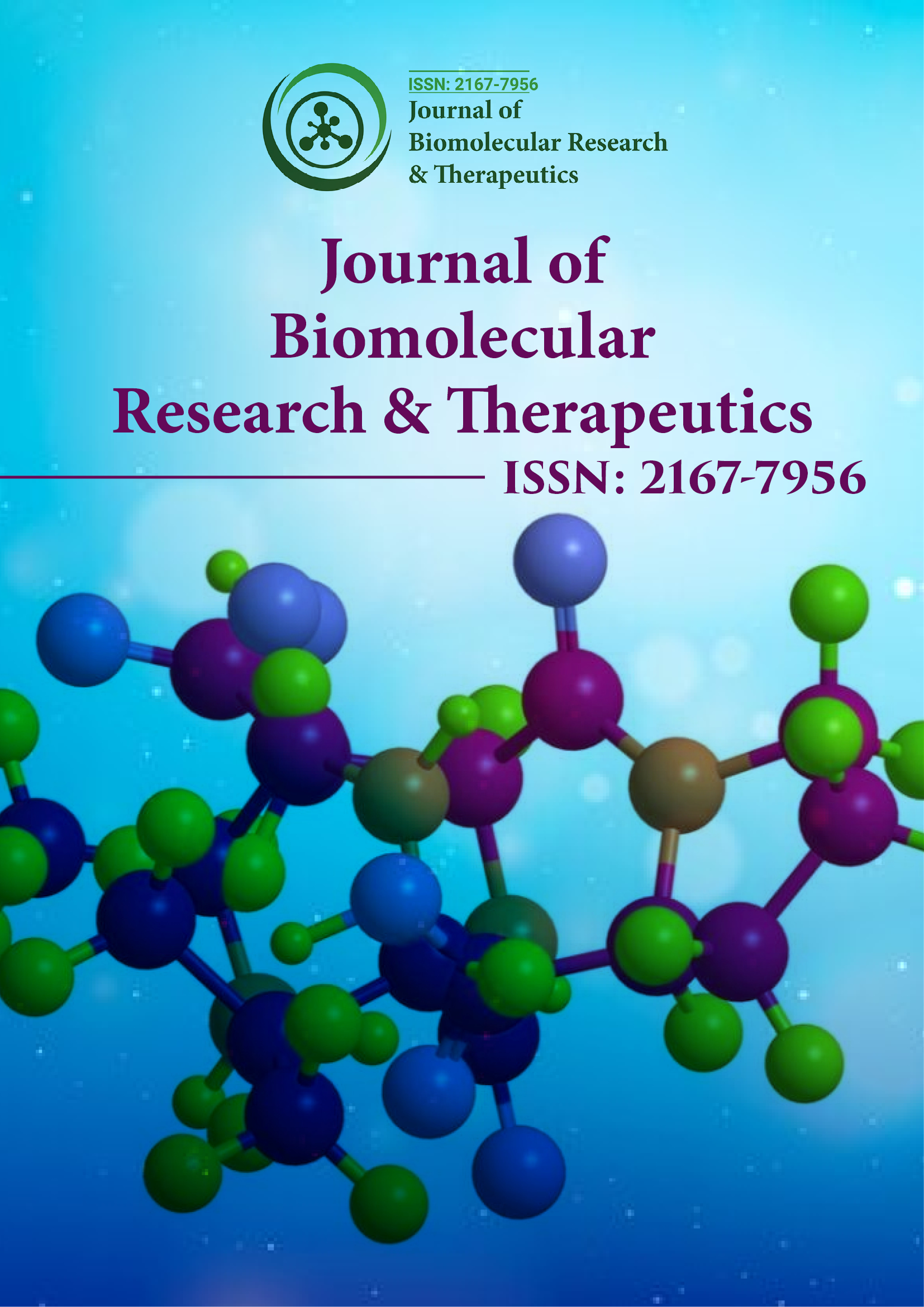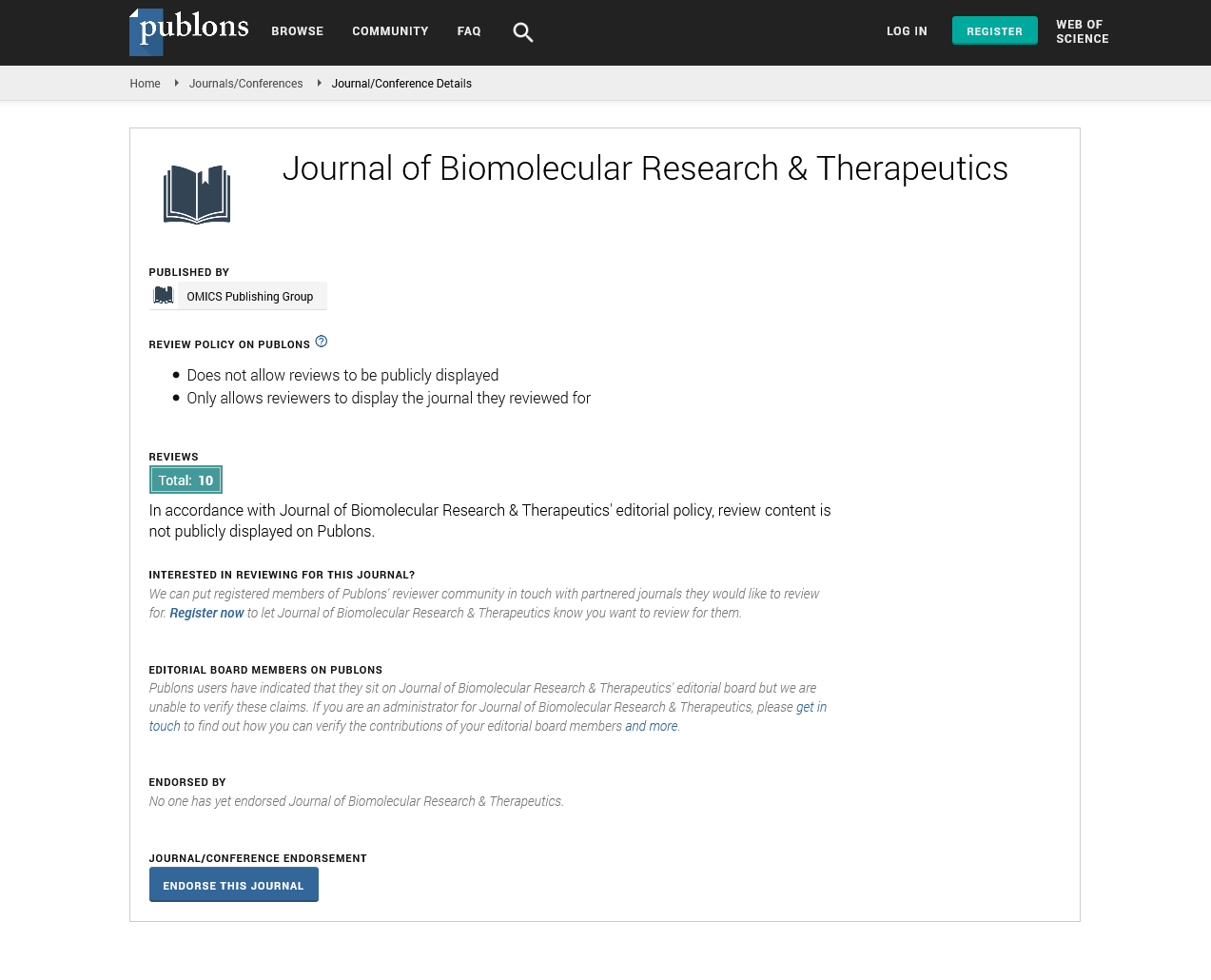Indexed In
- Open J Gate
- Genamics JournalSeek
- ResearchBible
- Electronic Journals Library
- RefSeek
- Hamdard University
- EBSCO A-Z
- OCLC- WorldCat
- SWB online catalog
- Virtual Library of Biology (vifabio)
- Publons
- Euro Pub
- Google Scholar
Useful Links
Share This Page
Journal Flyer

Open Access Journals
- Agri and Aquaculture
- Biochemistry
- Bioinformatics & Systems Biology
- Business & Management
- Chemistry
- Clinical Sciences
- Engineering
- Food & Nutrition
- General Science
- Genetics & Molecular Biology
- Immunology & Microbiology
- Medical Sciences
- Neuroscience & Psychology
- Nursing & Health Care
- Pharmaceutical Sciences
Perspective - (2025) Volume 14, Issue 1
Novel ADCs Targeting Fibroblast Activation Protein α: In Vitro Characterization and Xenograft Tumor Suppression
Rebecca Hughes*Received: 27-Jan-2025, Manuscript No. BOM-25-29384; Editor assigned: 29-Jan-2025, Pre QC No. BOM-25-29384; Reviewed: 12-Feb-2025, QC No. BOM-25-29384; Revised: 18-Feb-2025, Manuscript No. BOM-25-29384; Published: 26-Feb-2025, DOI: 10.35248/2167-7956.25.14.422
Description
Fibroblast Activation Protein-alpha (FAP - α) has emerged as a highly promising therapeutic target in the tumor microenvironment due to its selective overexpression on Cancer-Associated Fibroblasts (CAFs) in a wide range of solid tumors, including breast, pancreatic, colorectal and lung cancers. Unlike most tumor cell markers, FAP - α is not typically expressed in normal adult tissues, making it an ideal candidate for targeted therapies that minimize off-target toxicity. Its role in promoting tumor growth, metastasis, immunosuppression and extracellular matrix remodeling highlights its contribution to cancer progression. As a result, the development of Antibody-Drug Conjugates (ADCs) that selectively bind to FAP - α - expressing cells and deliver cytotoxic agents offers a novel and promising approach to targeting the tumor stroma and suppressing tumor growth more effectively than traditional therapies.
Antibody-drug conjugates combine the specificity of monoclonal antibodies with the potency of cytotoxic drugs, allowing for targeted delivery of chemotherapy directly to cancerous or tumor-supportive cells. In the context of FAP - α targeting, the ADC is engineered with a monoclonal antibody that binds specifically to FAP - α, a linker that is stable in circulation but cleavable within the tumor microenvironment and a cytotoxic payload that induces cell death once internalized. This multi-component design ensures selective action against FAP - α-expressing stromal cells and avoids damaging surrounding healthy tissue. By targeting the CAFs that form the supportive structure of many tumors, these ADCs disrupt key mechanisms of tumor maintenance, including immune evasion, angiogenesis and resistance to therapy.
In vitro characterization of these novel FAP - α - targeting ADCs involves a comprehensive evaluation of binding affinity, internalization efficiency, cytotoxic potency and selectivity. Typically, FAP - α - positive and FAP - α - negative cell lines are used to assess the ADC’s ability to differentiate between tumor-supportive and normal cells. Flow cytometry and immunofluorescence microscopy confirm receptor-specific binding, while internalization assays demonstrate that the ADCs are effectively internalized into FAP - α - expressing cells—a crucial step for delivering the cytotoxic payload. Moreover, cell viability assays reveal potent cytotoxic effects in FAP - α-positive stromal cells, while sparing FAP - α - negative counterparts, highlighting the high therapeutic index of the ADCs. These findings are often further supported by co-culture models of cancer cells and CAFs, which help to simulate the complex interactions within the tumor microenvironment and reveal how disrupting CAF activity may indirectly suppress cancer cell proliferation.
Beyond in vitro testing, the therapeutic potential of these ADCs is validated through in vivo xenograft tumor models, where human tumor cells are implanted into immunodeficient mice along with FAP - α - positive fibroblasts to recreate a human-like tumor microenvironment. In such models, treatment with the FAP - α targeting ADCs leads to significant tumor growth suppression compared to control groups. Tumor sections from treated animals often show decreased stromal density, increased apoptosis and reduced proliferation markers, suggesting that stromal targeting via FAP - α inhibition compromises the structural and biochemical support required for tumor survival. Importantly, the ADCs exhibit favorable pharmacokinetic properties and minimal systemic toxicity, supporting their potential for clinical application.
One of the key advantages of targeting FAP - α lies in its localization to the tumor stroma rather than cancer cells themselves. This provides a strategic benefit, especially in tumors with heterogeneous or low expression of traditional tumor antigens. Furthermore, the ability to modulate the tumor microenvironment opens the door to combination strategies with other therapeutic modalities. For instance, by depleting immunosuppressive CAFs, FAP - α - targeting ADCs may enhance immune infiltration and sensitize tumors to immune checkpoint inhibitors. Additionally, disrupting stromal architecture may improve vascular access and drug delivery, making tumors more responsive to chemotherapy or radiation.
Despite the promising results, several challenges remain. Ensuring that the ADCs maintain high specificity without inducing toxicity in FAP - α - expressing cells in wound healing or fibrotic tissues is essential for long-term safety. Also, careful optimization of the linker and payload is crucial to balance efficacy and minimize systemic exposure to the cytotoxic agent. Ongoing research is also investigating how FAP - α expression levels vary among different tumor types and stages, which will be important for patient selection and personalized treatment strategies.
In summary, novel ADCs targeting fibroblast activation protein-α represent a significant advancement in the development of stroma-directed cancer therapies. Through selective targeting of CAFs, these ADCs disrupt the tumor-supportive microenvironment, reduce tumor burden and potentially enhance the efficacy of other treatments. Both in vitro and in vivo studies confirm their ability to bind specifically to FAP - α, internalize effectively and deliver cytotoxic payloads with high precision. As research progresses, FAP - α - targeting ADCs could become an integral part of combination regimens, contributing to more comprehensive and durable responses in patients with solid tumors.
Citation: Hughes R (2025) Novel ADCs Targeting Fibroblast Activation Protein ?: In Vitro Characterization and Xenograft Tumor Suppression. J Biol Res Ther. 14:422.
Copyright: © 2025 Hughes R. This is an open access article distributed under the terms of the Creative Commons Attribution License, which permits unrestricted use, distribution AND reproduction in any medium, provided the original author and source are credited.

